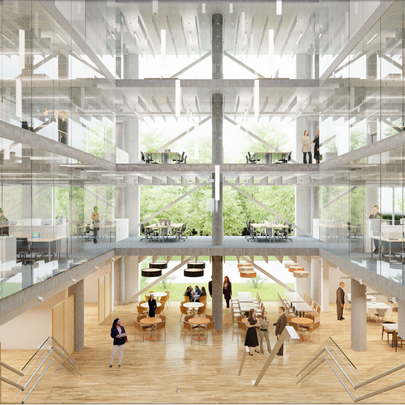Sluppenveien 17 – Pilot project
This is the first TABS project that Uponor has delivered in Norway.
• 8 floors in total
• Area: 10,000 m2
• Basement level with car park
• Central atrium in the building covering 7
floors.
• Kjeldsberg Eiendom
• Energy class A
Uponor in Sluppenveien 17
Uponor has delivered several plumbing systems for the project in Sluppenveien:
• 66,000 metres of Uponor pePEX piping for cooling
• Uponor floor heating system in changing rooms
• Uponor Uni-Pipe composite pipe for supply pipelines
• Uponor Tap Water Systems PEX Pipe in Pipe
TABS – Thermally Active Building Systems; Thermally active slabs
TABS – Thermally Active Building System is a principle for thermal activation of concrete slabs with embedded water loop pipes. The excess heat in the room rises upwards where it is stored in the slabs above. PePex pipes are embedded in the concrete slabs and circulating water draws the heat out from the thermal slabs and out of the building. The system is primarily a cooling system but can also be used to meet the heating needs in the building. The temperature in the room will vary throughout the day from a minimum value up to a maximum value. At night, the room temperature is usually lowered back to the selected minimum value. - and the cycle starts again. TABS is suitable for most building types.
TABS in brief
• Cooling using the slab structure
• The entire floor area is covered with pipes
• Can be used for ground heat during winter
• Waterborne system integrated in the slabs
• Used in industrial buildings, schools, theatres, hospitals, libraries and museums
• Energy supply at night only
• Zone portioning of the building
• Easy to adjust
• Optimal use together with heat pumps and ground source heat exchangers
• Saves energy Operating costs are reduced by 30-50%
• Large, clean roof surfaces
• Large spans
• Cooling capacity: 40-60 W/m2
• Heating capacity: 30 W/m2
Greater freedom for the architect
The solution provides optimal use and distribution of energy. The architect and building advisor gain new and exciting possibilities for the building design. Smooth roofs without ceilings is one such possibility. There is no energy supply to the building during the day. The circulation pump for the water is not in operation during daytime hours!
System description
The temperature starts at a selected level in the morning, e.g. 20°C, and we allow the temperature to rise up to max.
26°C, which is achieved at the end of the school day. (Other temperatures can be chosen), or at a predefined time. Alternatively, both factors can be combined.
The heat generated in the room during the day rises upwards and into the slab structure where the energy is stored. When the peak temperature in the room has been reached, the pump will start to circulate coolant through the pipes. The water will draw the heat from the slabs and out of the building. The room temperature will then decrease again and will, over time, return to the starting point of 20°C (or the temperature selected)
The temperature drop will take place at night when the building is empty.
Cooling or heating
A TABS system is first and foremost a cooling system but can also be used as a heating system. Manual changeover takes place when the season changes. A date for the system changeover is chosen. This is easy, reliable and affordable. The building is split into zones.
A thermally active slab can be implemented in several ways and is just as suitable in a slab cast on-site as in a
BubbleDeck. With a BubbleDeck, long spans (up to 16 metres) and large cantilevers can be achieved
A TABS system will be fully dimensioned before the building is erected!
1. Formwork is established.
2. Mark the position of the pipe distribution unit so that the pipelines between the modules and the distribution unit are adapted and visualised in the formwork and reinforcements.
3. The first phase of reinforcements are laid on the formwork.
4. Modules with pipes are prefabricated and pressurised (2.5 Bar) – and kept under constant pressure during the installation phase until they are connected to the distribution unit.
5. Modules with pipes are placed in the proper places and attached on top of the first phase of reinforcements.
6. Flow and return pipes are laid on the distribution unit
point and at least 1 metre above the top of the fully cast slabs. Distribution units are connected to the pipes
using Quick & Easy (Q&E).
The contractor K. Lund has been in close contact with
Uponor's technical division in Germany. It is important to ensure that all loops are of the same length, as the system does not require initial adjustment. This also means that any changes during the process need to be correctly designed.
Uponor in Sluppenveien 17
Uponor Ltd
View company profile| T | (01923) 927 000 |
|---|---|
| F | (01455) 550 366 |
| E | enquiries.uk@uponor.com |
| W | Visit Uponor Ltd's website |
| The Pavilion, Blackmoor Lane, Watford, WD18 8GA |
Categories
Central heating systems Warm air heating


